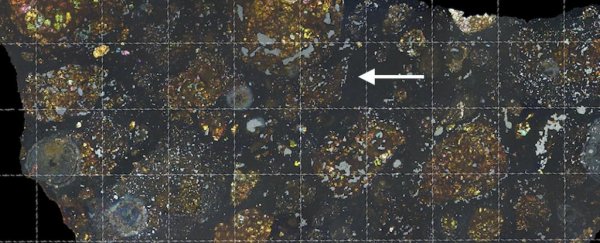Meteorites are a bit like fruitcake - chunks of mineral held together by a stone matrix. Those mineral inclusions can contain some pretty fascinating glimpses into the stuff of the Solar System - but now scientists have found something they've never seen before.
In a meteorite recovered from Antarctica in 2002 is a tiny, ancient sliver of the building blocks of comets - encased, the researchers said, like an insect in amber.
The meteorite is called LaPaz Icefield 02342 (LAP 02342 for short), and it's a type of meteorite known as a carbonaceous chondrite.
Meteorites come in a variety of types, broken off from larger pieces of space rock such as asteroids or even planets, and sent hurtling through space until they collide with Earth, after surviving the often explosive effects of atmospheric entry.
Their composition can vary, and that's used for meteorite classification. Carbonaceous chondrites are among the most primitive, thought to originate from asteroids that formed around 4.5 billion years ago - when the Solar System was also forming - out past the orbital range of Jupiter.
Comets, too, formed from the same protoplanetary disc of dust and gas that circled the newborn Sun, but much farther away than asteroids, so their composition is different. They have a lot more water ice - that is what creates the famous tail when they get close to the Sun. And they have a lot more carbon.
The team wasn't actually looking for comet giblets. Meteorites are a sort of time capsule to the early Solar System, rich with presolar grains, and information about the heating and chemical processes present during the system's formation.
But comet giblets is what they got.
 (Larry Nittler/Carnegie Institution for Science)
(Larry Nittler/Carnegie Institution for Science)
"When I saw the first electron images of the carbon-rich material," said cosmochemist Jemma Davidson of Arizona State University, "I knew we were looking at something very rare. It was one of those exciting moments you live for as a scientist."
That tiny carbon-rich sliver, measuring just a tenth of a millimetre, bore strong similarities to interplanetary dust particles and micrometeorites thought to originate in comets that formed in the Kuiper Belt at the icy outskirts of the Solar System.
The team conducted isotopic analysis of the sliver, and concluded that it likely formed in the same place and in the same way.
Its inclusion in a meteorite suggests that it must have migrated inward from this starting position, drawing slowly closer to the Sun until it reached the region where the carbonaceous chondrites formed.
Then, around 3 to 3.5 million years after the formation of the Solar System, this microscopic sliver somehow, perhaps via a collision, became incorporated into the asteroid that would fragment to produce LAP 02342.
The comet speck has opened up a window into the dynamics and chemistry of the early Solar System, and the chemistry of the protoplanetary disc at various distances.
"Because this sample of cometary building-block material was swallowed by an asteroid and preserved inside this meteorite, it was protected from the ravages of entering Earth's atmosphere," said cosmochemist Larry Nittler of the Carnegie Institution for Science.
"It gave us a peek at material that would not have survived to reach our planet's surface on its own, helping us to understand the early Solar System's chemistry."
The research has been published in Nature Astronomy.
